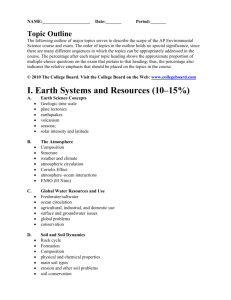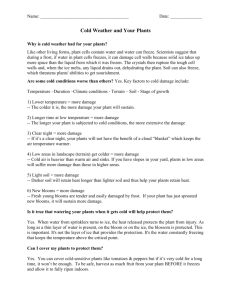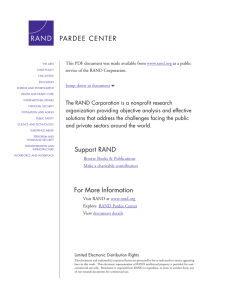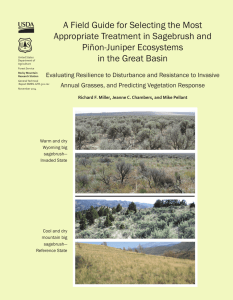Sustainable Agriculture - Oregon State University
advertisement
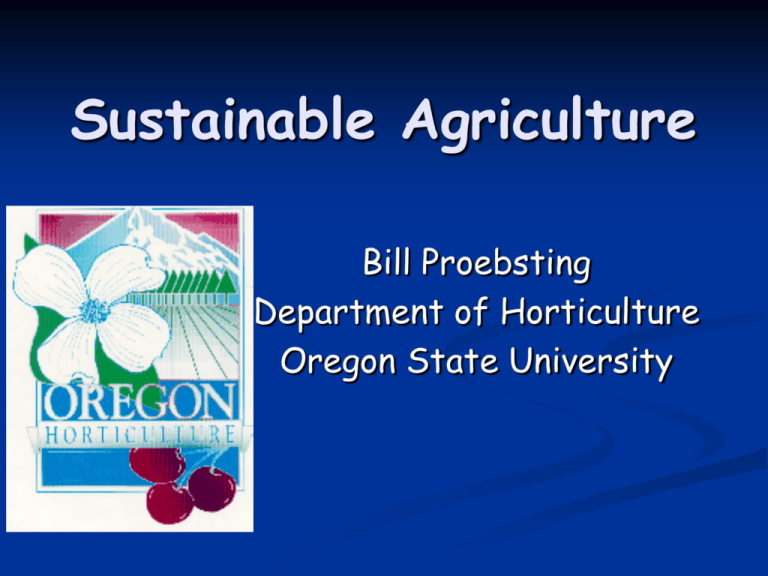
Sustainable Agriculture Bill Proebsting Department of Horticulture Oregon State University Fire and Ice Robert Frost Some say the world will end in fire, Some say in ice. From what I’ve tasted of desire I hold with those who favor fire. But if it had to perish twice, I think I know enough of hate To know that for destruction ice Is also great And would suffice. Sustainable Agriculture Meeting the needs of the present without compromising the ability of future generations to meet their own needs Sustainable Agriculture: An Oxymoron “our farming has never been sustainable” Wes Jackson “agriculture represents the single most profound ecological change in the entire 3.5 billion year history of life” Niles Eldredge “the fact that we have not yet invented a truly sustainable agricultural system means that we have not yet achieved a truly sustainable civilization” Ward Chesworth U.S. Agricultural Policy “In actual fact, American agricultural policy distorts food prices, frustrates innovation, limits product diversity and subsidizes a select group of farmers at enormous public cost.” National Cattlemen’s Beef Association http://www.beefusa.org/NEWSUSFarmBill2002ItsImplicationsforWorldAgriculturalMarkets11148.aspx U.S. Industrial Agriculture System of crop production that results in: Destruction of soil Overuse of energy, water, fertilizer, chemicals Wreckage of rural societies and economies Are these good things or bad things? Sustainable or unsustainable? Capitalism 1) 2) 3) Market-driven system Some level of government involvement As currently practiced, the system is flawed Natural Capitalism Manufactured Capital; infrastructure, machines, tools, factories Financial Capital; cash, investments, monetary instruments Human Capital; labor, intelligence, culture, organization Natural Capital; resources, ecosystems Industrial Capitalism Fails to assign value to natural, social or cultural systems Thus, it fails to live by basic accounting principles and is not sustainable Industrial Capitalism, cont. “Free enterprise and market forces will allocate people and resources to their highest and best uses” Can’t be true without accounting for natural capital Industrial Capitalism, cont. “Resource shortages will elicit development of substitutes” Substitutes for: Soil Air Water Functional ecosystems Industrial Capitalism, cont. “Concerns for a healthy environment are important but must be balanced against the requirements for economic growth if a high standard of living is to be maintained” Current Social System Environment Economy Social Justice Gross National Product Index of Sustainable Economic Welfare ISEW = personal consumption + non-defensive public expenditures - defensive private expenditures + capital formation + services from domestic labor - costs of environmental degradation - depreciation of natural capital http://www.rprogress.org/newprograms/sustIndi/gpi/index.shtml Why does the environment matter? Ecosystem Services: Things that nature provides for free Climate stability Weather moderation Clean air Clean water Flood control Nutrient cycling Waste removal Soil formation Insect control Pollination Seed dispersal Biodiversity Value roughly $30 trillion ($30 x 1012) Replicating Ecosystem Services http://facultystaff.vwc.edu/~gnoe/EES_ENVS/biosphere4a.jpg Ecosystem Services of Biosphere 2 >$150 million 8 persons Produced 80% of food requirements Ecological collapse Atmospheric change $20 million x 6.5 billion people = $13 x 1016 Ecosystem Services Are Important: What’s the Problem? Are we really having a significant impact? Ecological Overshoot of the Human Economy PNAS 99, 9266 (2002) Ecosystem Services related to Agriculture Soil 2 billion tons of soil eroded per year from agricultural lands Costs $44 billion per year Lost productivity Water pollution Silting of reservoirs 90% of U.S. land eroding above replacement rates Growing a bushel of corn costs 2-5 bushels of top soil Soil Carbon Science 277, 507 (1997) Nitrogen Crop Yield Nitrogen Efficiency Nature 418, 671 (2002) Nitrogen Run-off Groundwater contamination Streams, lakes and wetlands Gulf of Mexico Dead Zone http://www.ers.usda.gov/amberwaves/november03/findings/images/photo_deadzone.jpg Ocean Dead Zones http://www.classzone.com/books/earth_science/terc/content/investigations/es2206/es2206page04.cfm Water Ag accounts for 80% of water used in U.S. Depletion of stream flows, water quality, fish and wildlife Federal projects deliver water below cost Depletion of aquifers Ogallala Aquifer Aral Sea Energy Industrial agriculture is energy intensive: Tilling, planting, spraying, harvesting Synthesizing fertilizer, irrigating Processing Transporting For each food calorie produced, 10 calories of oil are consumed "It costs 435 fossil fuel calories to fly a 5-calorie strawberry from California to London." Energy in Agriculture Based on energy use alone, agriculture is about 90% unsustainable Industrial agriculture can never be sustainable, because it relies on fossil fuels Only energy generation directly from sun, sun-driven wind and water can be sustainable Good News! We have many exciting challenges to devise a sustainable agriculture Towards Sustainable Agriculture 1) 2) 3) 4) Account for natural capital Remove or change subsidies Tax “bads,” instead of “goods” Emphasize ecological, rather than technological approaches to agriculture and other activities Science 309, 570 (2005) Characteristics of Sustainable Agriculture 1) 2) 3) 4) Energy generated on farm Mimic natural systems Use of perennial plants Locally-grown food A locally-grown meal requires about 6-10% of the energy use of a standard American meal http://www.energybulletin.net/4492.html Natural Systems Agriculture Developing systems to, “rely on the ecological benefits of natural ecosystems with no or minimal sacrifice in food production.” Wes Jackson, The Land Institute Modeled on prairies Perennial plants Species diversity Powered by the sun http://www.landinstitute.org/ Major Questions Is there a trade-off between perennialism and seed yield? Can a perennial polyculture outyield a monoculture? Can perennial polycultures defend themselves? Can a perennial polyculture supply its own nitrogen? http://www.landinstitute.org/ Is There a Role for Biotechnology in Sustainable Agriculture? Problems of agriculture are much bigger than genetic engineering Presently, biotechnology is, at best, basically irrelevant to developing sustainable agriculture At worst, it perpetuates a disastrous system Is There a Role for Biotechnology in Sustainable Agriculture? Ethical questions, mostly narrow the debate about risk Natural? Toxic? Genetic pollution? Invasive? Risks vs. Benefits Industrial agriculture is unsustainable. Is There a Role for Biotechnology in Sustainable Agriculture? Are single gene approaches suitable for addressing complex problems? Insect resistance Herbicide resistance May or may not have had some positive environmental effect, but very little effect on “Sustainability” Focus Questions What are the consequences of developing, or not developing, sustainable agriculture? What are some genetic traits that might have a major impact on developing sustainable agriculture? Fire and Ice Robert Frost Some say the world will end in fire, Some say in ice. From what I’ve tasted of desire I hold with those who favor fire. But if it had to perish twice, I think I know enough of hate To know that for destruction ice Is also great And would suffice.
